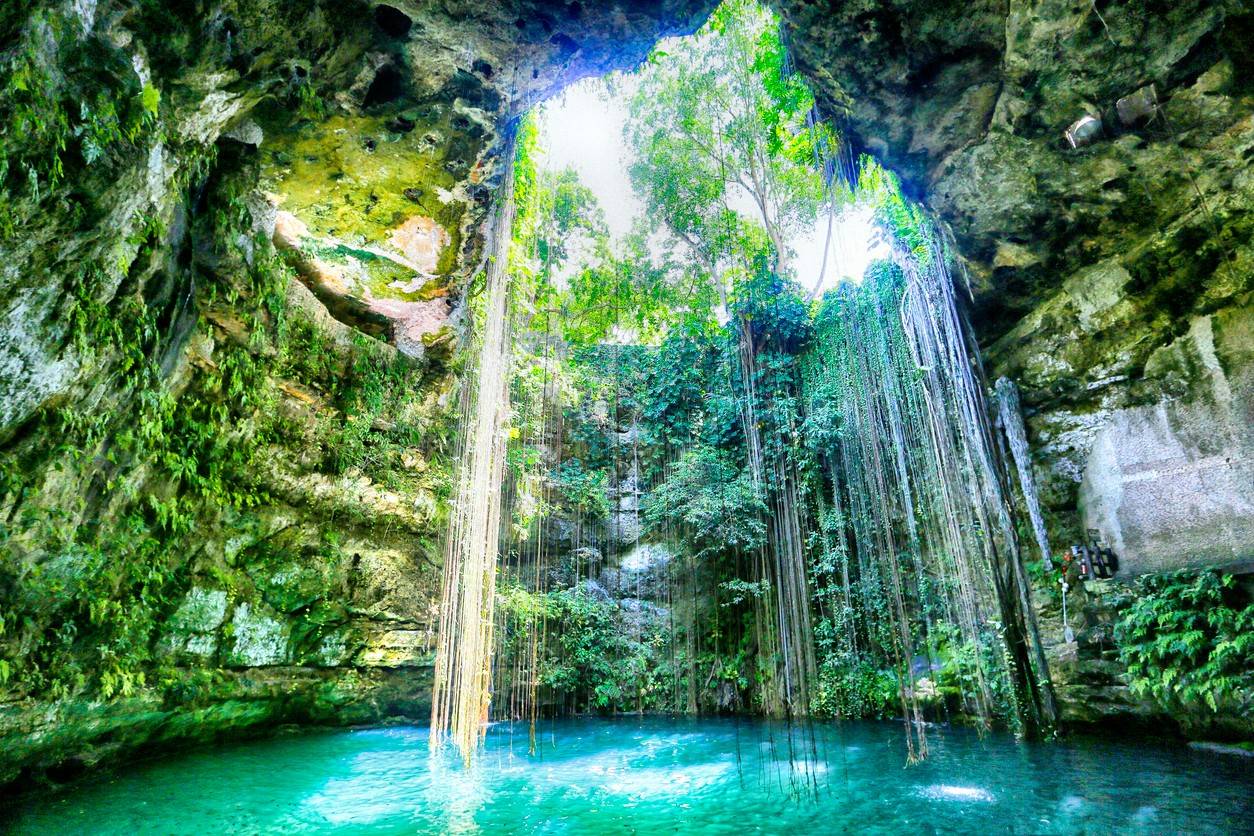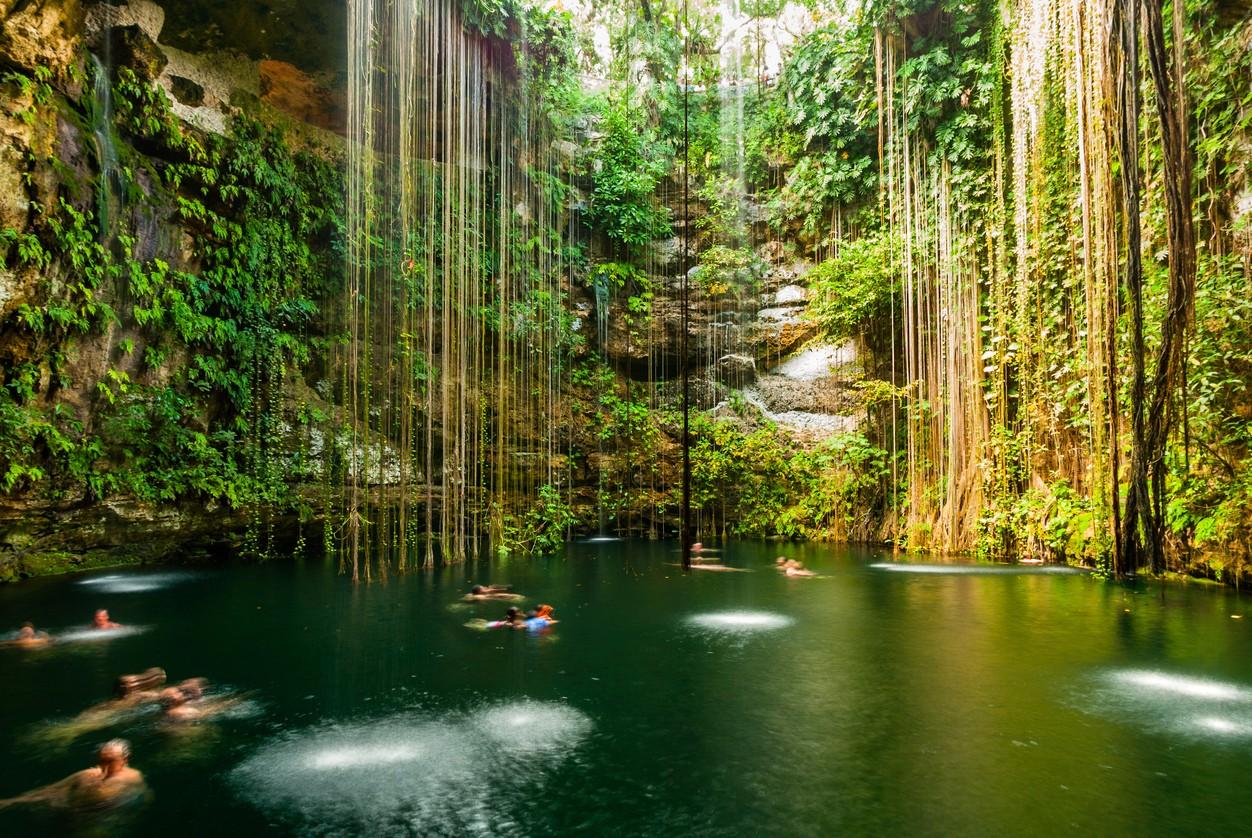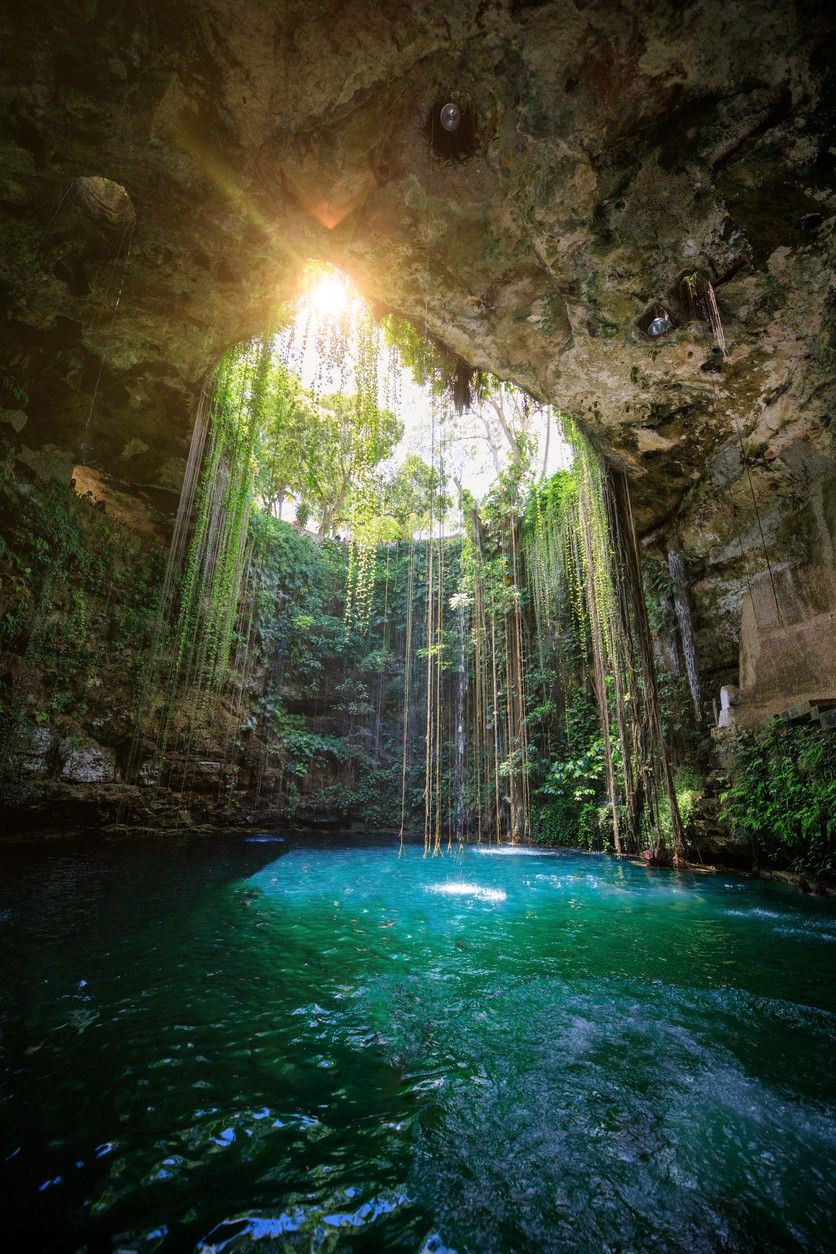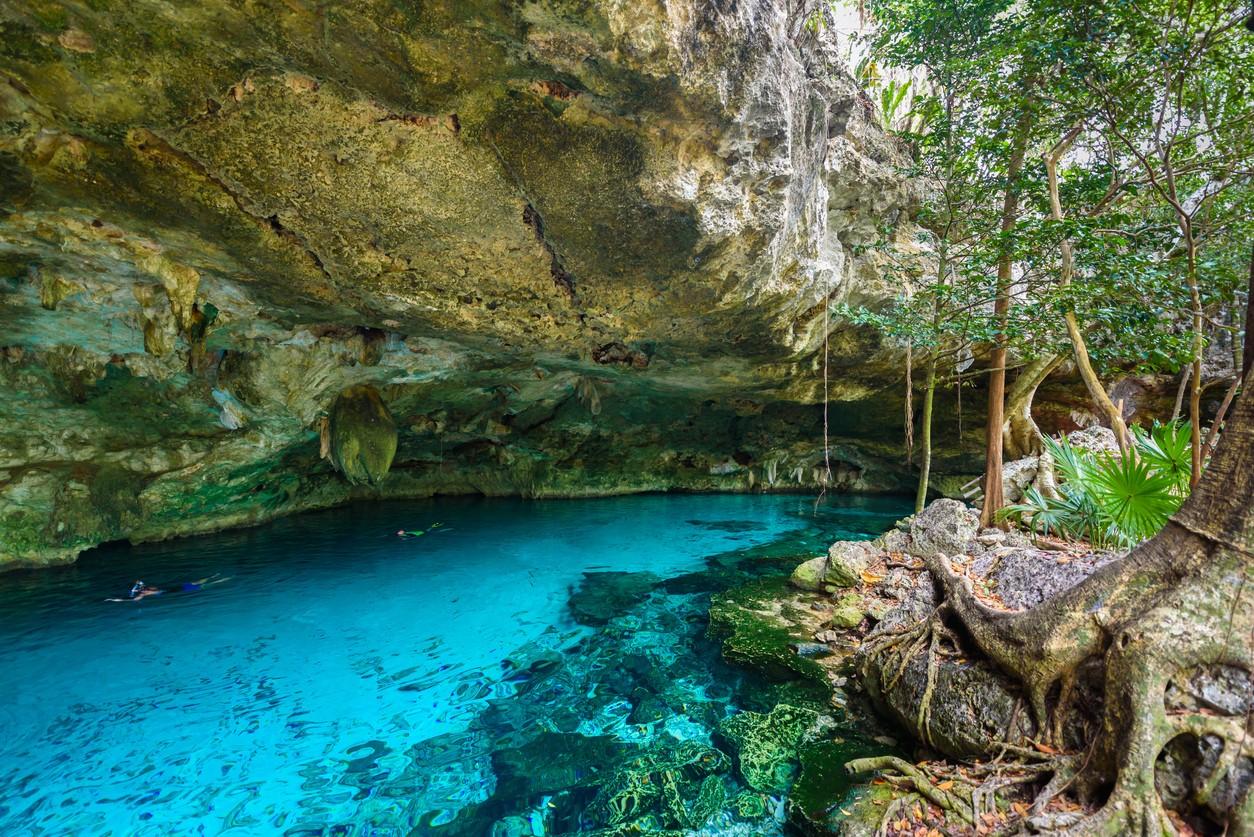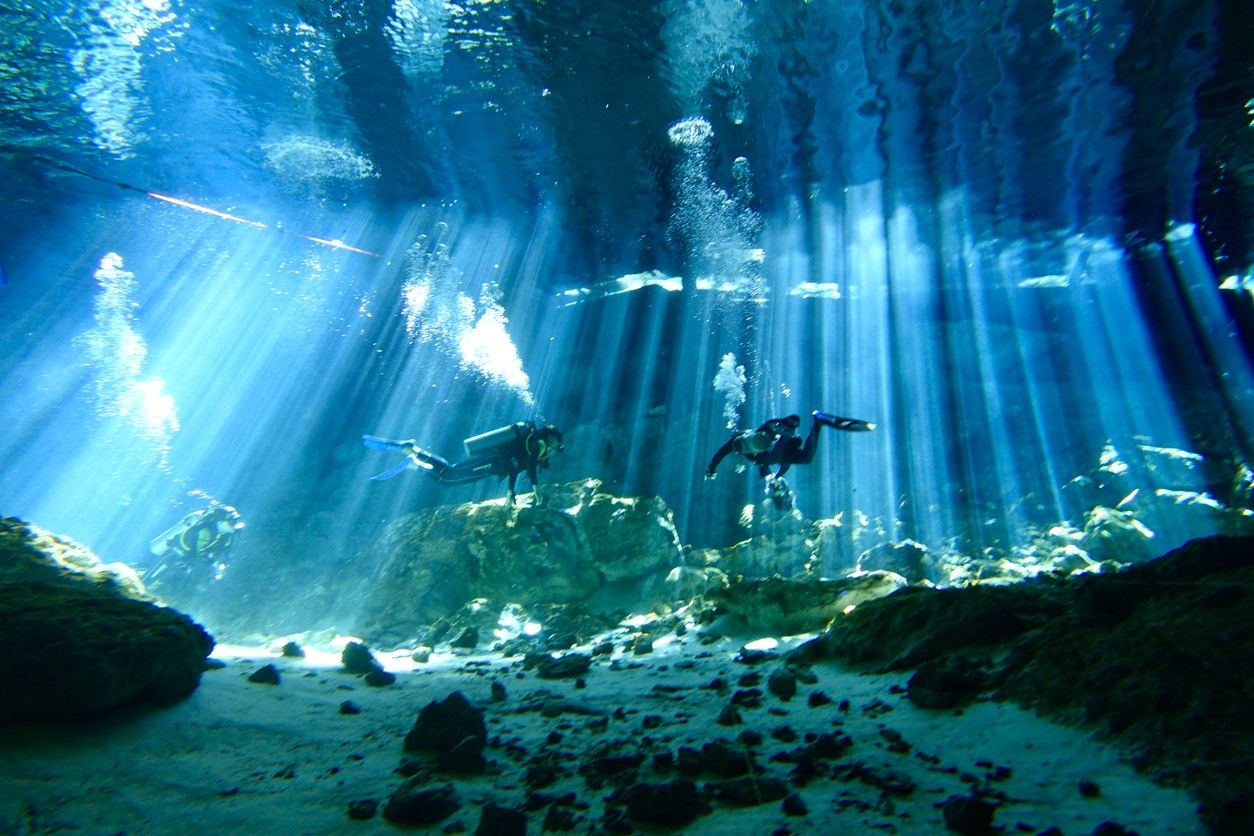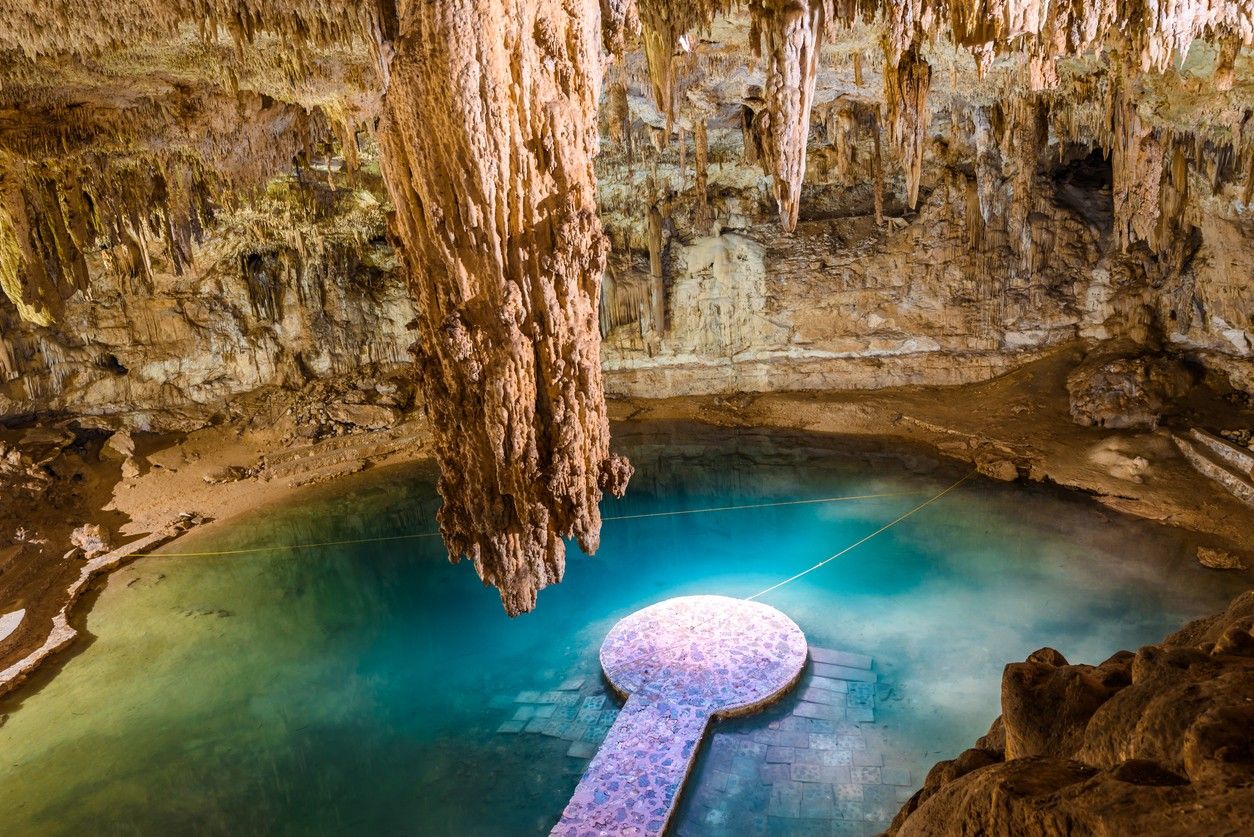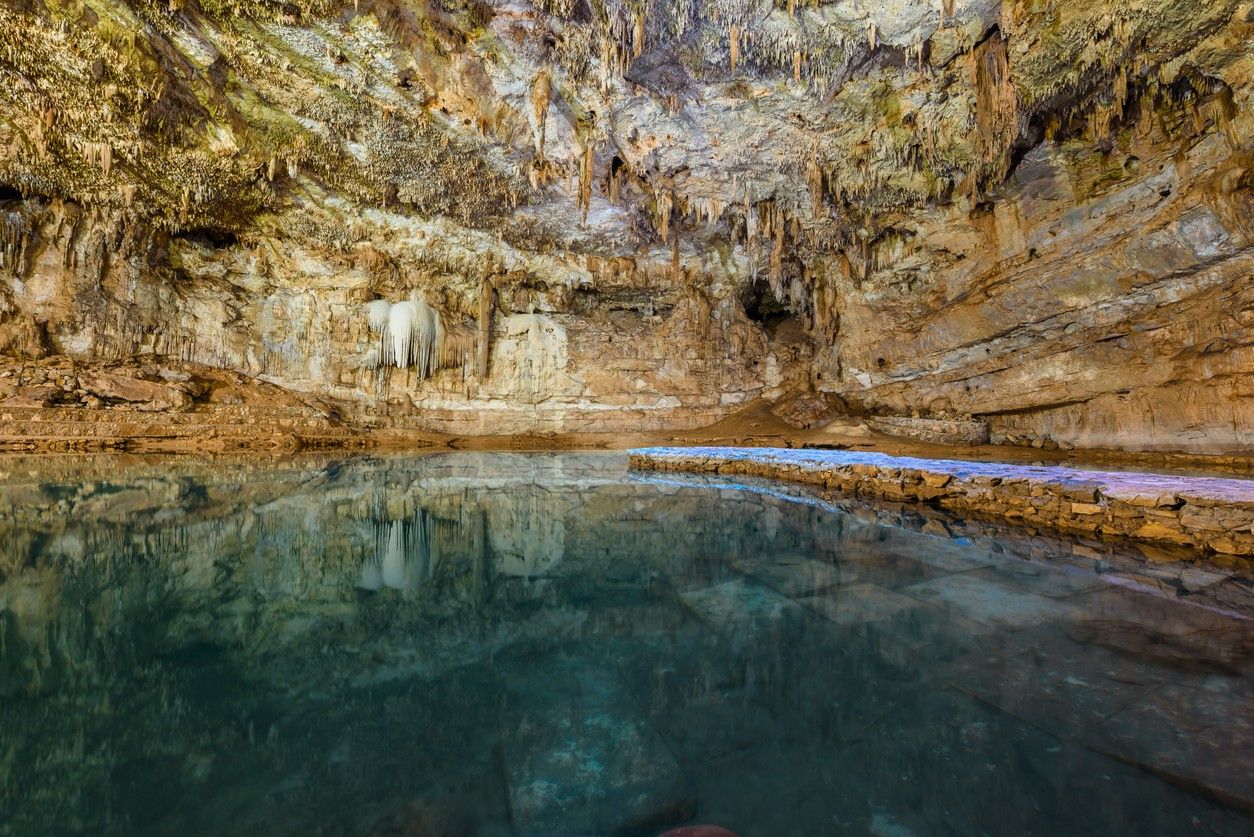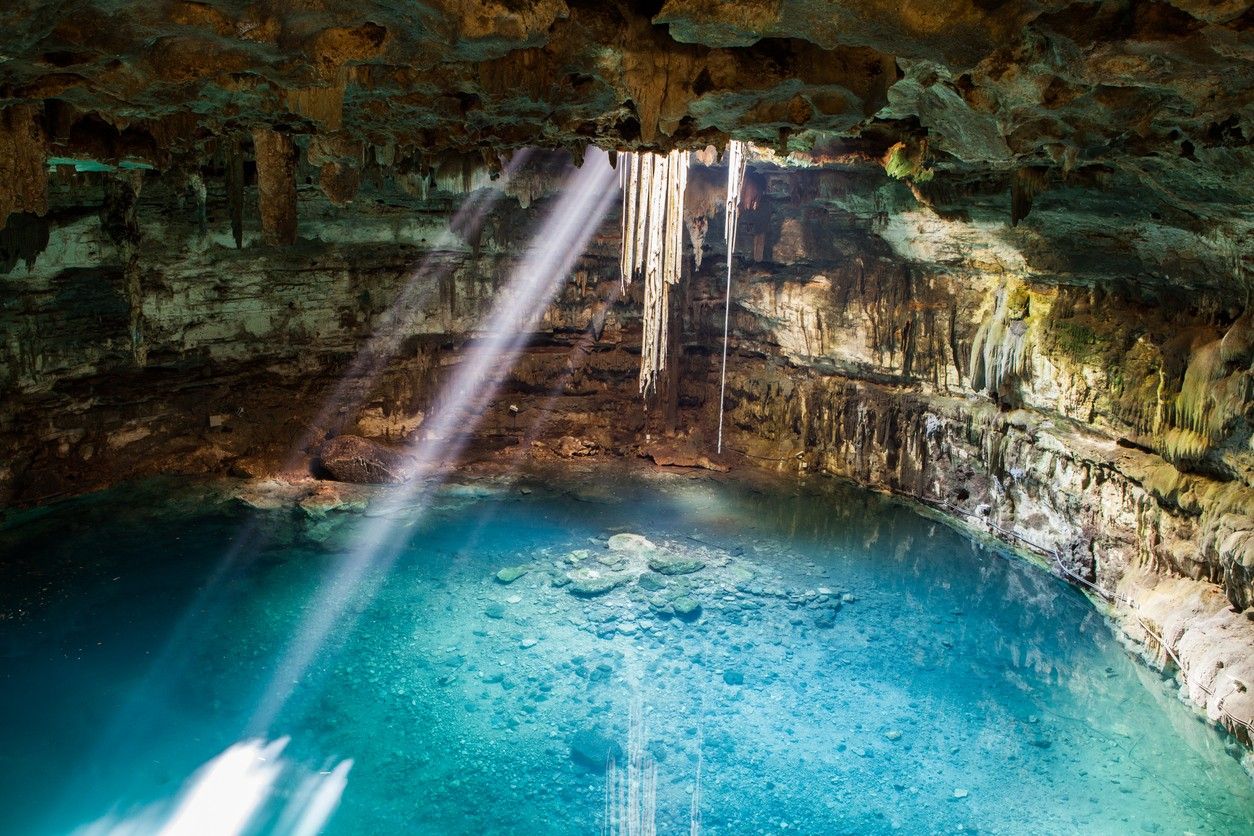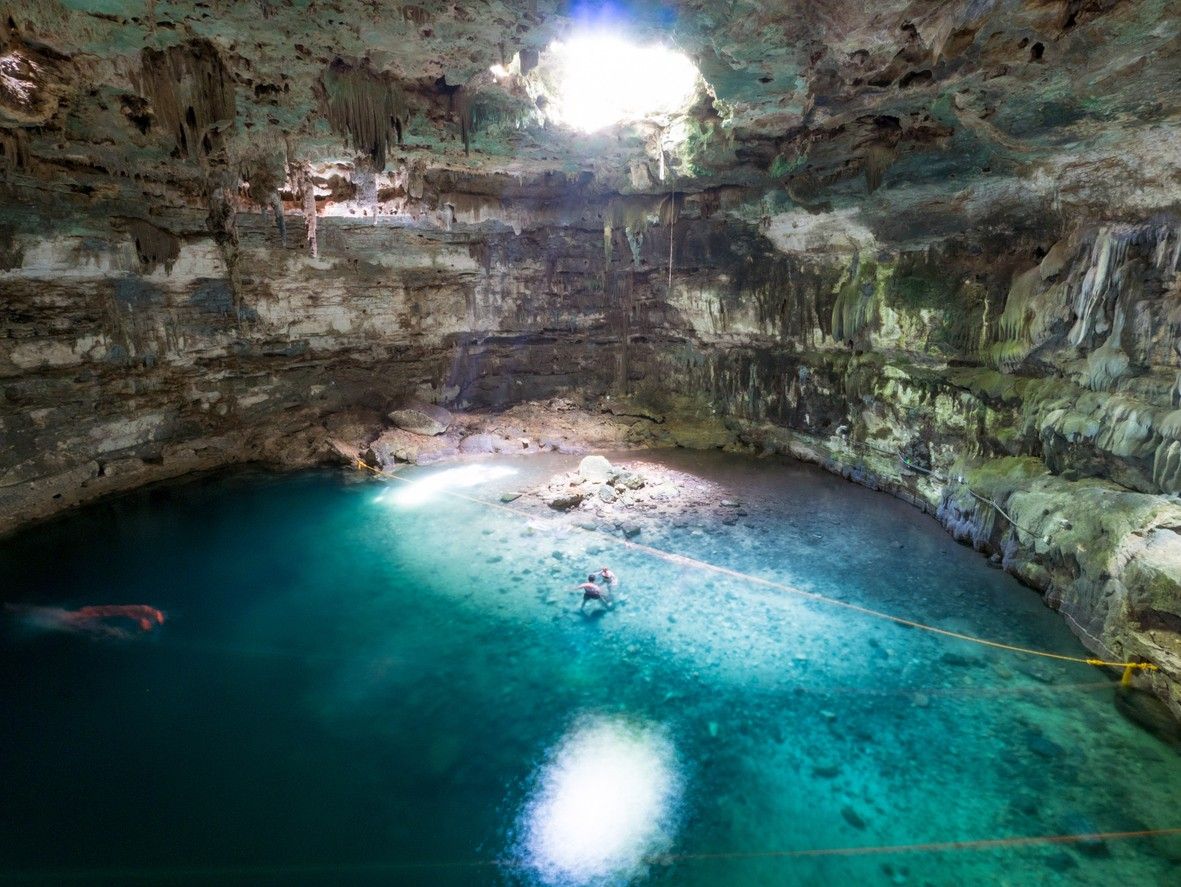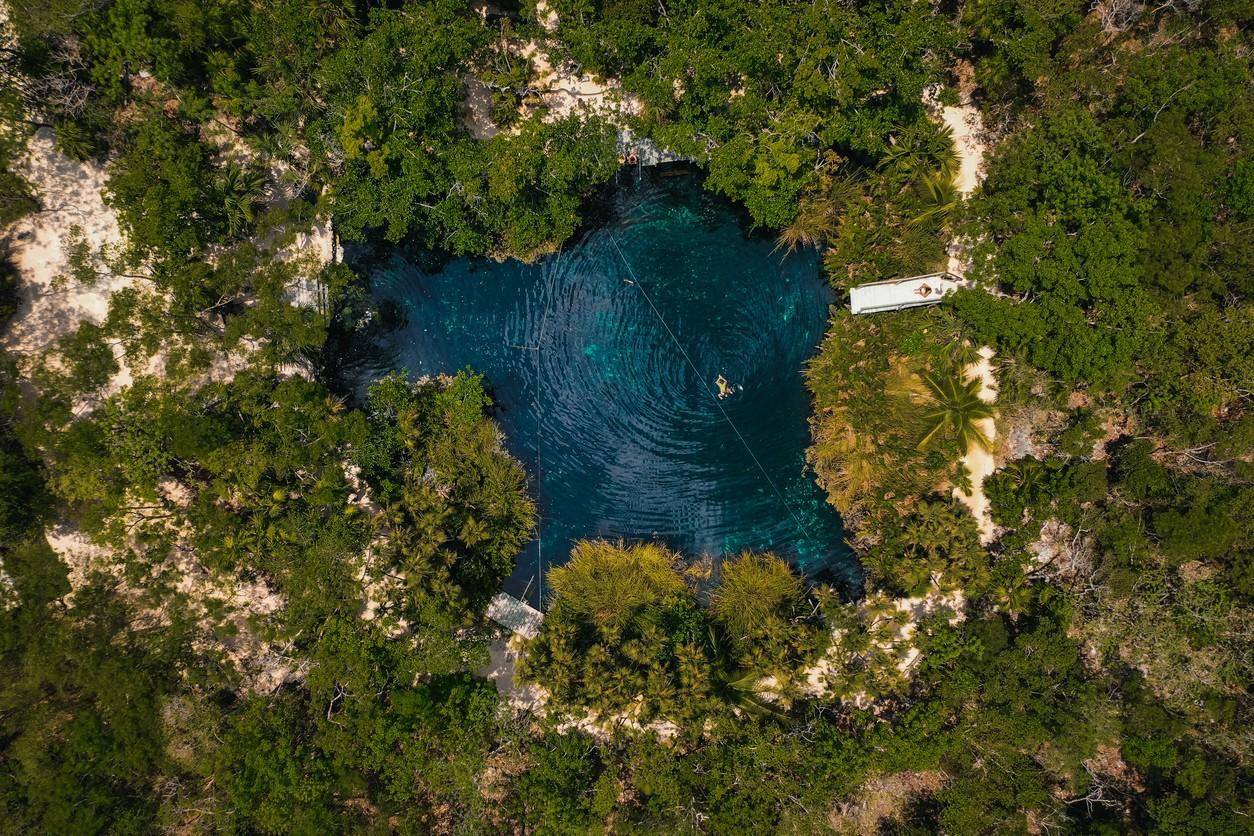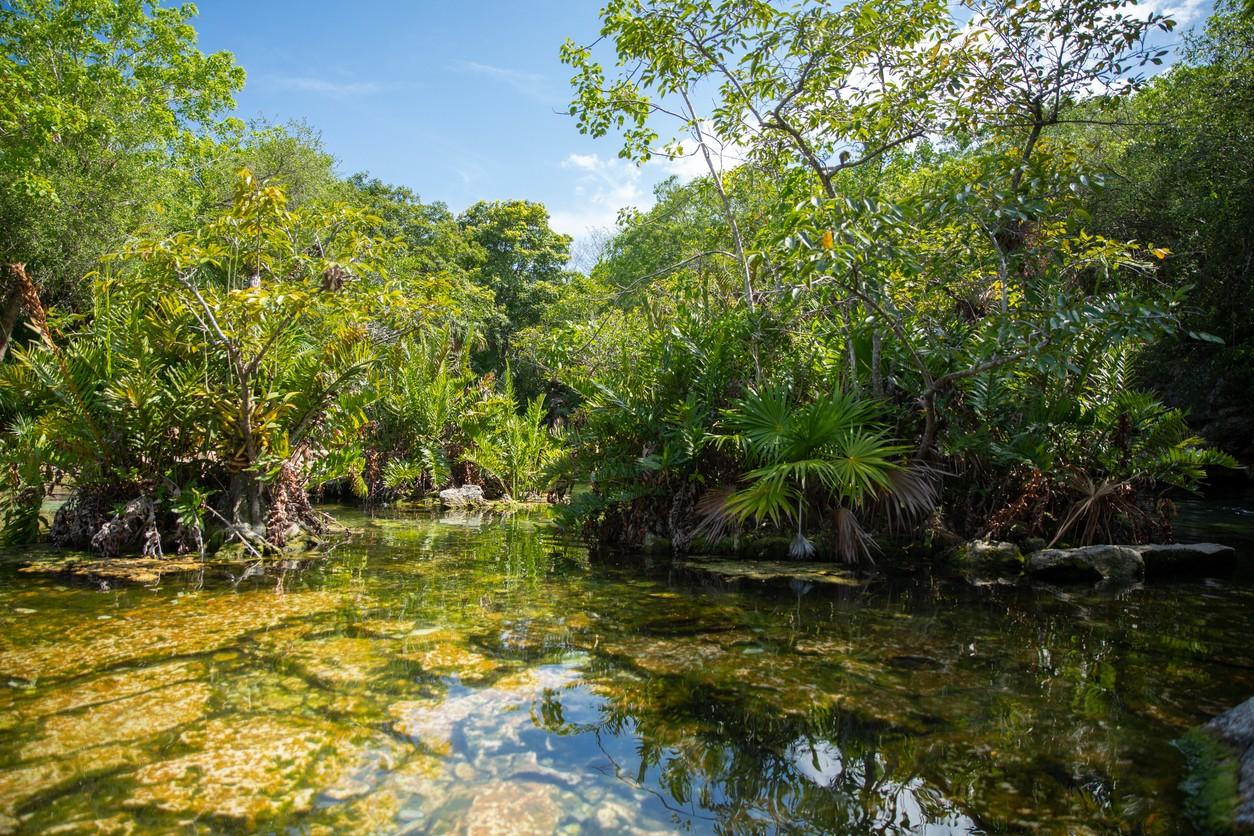Cenotes are a unique and fascinating natural wonder found throughout Mexico, particularly in the Yucatan Peninsula. These sinkholes, formed by the collapse of limestone bedrock, expose groundwater underneath and create stunning pools of crystal-clear water. Cenotes have played a significant role in the history and culture of Mexico, serving as sacred sites for the ancient Maya civilisation and now attracting visitors from around the world who come to marvel at their beauty and enjoy various recreational activities. Mexico is home to over 6,000 cenotes, with the majority located in Quintana Roo, Yucatan, and Campeche. These cenotes come in various shapes and sizes, ranging from small, intimate pools to large, open-air sinkholes. Some cenotes are easily accessible, while others require a more adventurous spirit to reach. Regardless of their location or size, each cenote offers a unique and unforgettable experience for those who visit.
The formation of cenotes results from the Yucatan Peninsula's unique geology. The peninsula is composed of a thick layer of limestone, which is a porous rock that allows water to pass through easily. Over millions of years, rainwater has slowly dissolved the limestone, creating a vast network of underground rivers and caves. When the roof of one of these caves collapses, it forms a cenote. Cenotes have been an important part of Mexican history and culture for thousands of years. The ancient Maya civilisation considered cenotes to be sacred places, believing them to be portals to the underworld. They would perform religious ceremonies and make offerings to their gods at these sites. Today, many cenotes still hold spiritual significance for the local communities, and visitors are encouraged to respect these beliefs and traditions.
Cenotes also play a crucial role in the ecology of the Yucatan Peninsula. They serve as a vital source of freshwater for the region's flora and fauna, and many species of fish, turtles, and other aquatic life call these underwater caves home. The crystal-clear waters of cenotes also support a diverse array of plant life, including algae, mosses, and ferns. Cenotes have become increasingly popular tourist attractions in recent years, drawing visitors from around the world who come to swim, snorkel, and dive in their pristine waters. Many cenotes have been developed into eco-parks, with amenities such as changing rooms, restrooms, and restaurants. Visitors can also take guided tours to learn more about the history and ecology of these unique natural wonders.
Cenote Ik Kil
Cenote Ik Kil is one of the most famous and frequently visited cenotes in Mexico, located near the ancient Mayan ruins of Chichen Itza in the Yucatan state. This stunning open-air cenote is approximately 40 meters deep and is known for its circular shape and the lush vegetation surrounding it. The name "Ik Kil" translates to "place of the winds" in the Mayan language, which is fitting given the small waterfalls and hanging vines that sway gently in the breeze along the cenote's walls, creating a magical atmosphere. The water is a mesmerising turquoise colour and so clear that the bottom is visible from the surface. Visitors can access the water via a carved stairway leading down to a swimming platform. From there, it's possible to jump into the refreshing water and enjoy a swim in this natural wonder. Due to its depth, it's important to exercise caution and follow all safety guidelines when swimming in Cenote Ik Kil. The underwater world of Cenote Ik Kil is just as fascinating as the surface, with a variety of fish and other aquatic life to observe. Experienced divers can even explore the underwater caves that branch off from the main cenote. The site has been developed into an eco-park with amenities such as changing rooms, restrooms, and a restaurant. There are also several nearby hotels and resorts, making it easy to plan a visit to this incredible natural wonder. To avoid crowds, it's best to arrive early in the morning or later in the afternoon, especially during peak tourist season. Visitors should also bring biodegradable sunscreen and insect repellent, as well as a towel and any snorkelling or diving equipment they may need.
Beyond its natural beauty, Cenote Ik Kil holds cultural significance. The ancient Maya believed that cenotes were sacred places, and Ik Kil was likely used for religious ceremonies and as a source of fresh water for the nearby city of Chichen Itza. The formation of Cenote Ik Kil results from the unique geology of the Yucatan Peninsula. The peninsula is composed of a thick layer of limestone, a porous rock that allows water to pass through easily. Over millions of years, rainwater has slowly dissolved the limestone, creating a vast network of underground rivers and caves. When the roof of one of these caves collapses, it forms a cenote like Ik Kil. The cenote's circular shape and steep walls are a testament to the power of nature and the passage of time. The lush vegetation that surrounds the cenote adds to its beauty and creates a unique ecosystem that supports a variety of plant and animal life. Visitors to Cenote Ik Kil can take a moment to appreciate the incredible natural processes that have created this stunning wonder. Cenote Ik Kil is also an important part of the local economy. The eco-park and nearby hotels and resorts provide jobs for many residents and help to support the region's tourism industry. By visiting Cenote Ik Kil and other natural attractions in the Yucatan Peninsula, tourists can help support sustainable tourism practices that benefit both the environment and local communities.
Cenote Dos Ojos
Cenote Dos Ojos, which translates to "Two Eyes Cenote" in English, is a fascinating underwater cave system located just north of Tulum in the state of Quintana Roo. The cenote is named for the two neighbouring sinkholes connected by a long, narrow passageway. What sets Cenote Dos Ojos apart from other cenotes in the region is its extensive network of underwater caves. The cave system stretches for over 61 kilometres, making it one of the longest underwater cave systems in the world. The crystal-clear water and stunning rock formations create an otherworldly landscape that is truly wondrous to behold. Cenote Dos Ojos is a popular spot for both snorkelling and diving. The cenote's shallow waters are perfect for snorkelers, who can explore the stunning underwater world without needing any special equipment or training. The water is so clear that the bottom, covered in a layer of white limestone sand, is easily visible.
For more experienced divers, Cenote Dos Ojos offers an incredible opportunity to explore the extensive underwater cave system. The caves are filled with stunning rock formations, including stalactites and stalagmites, and are home to a variety of aquatic life, including fish and turtles. One of the most popular diving routes in Cenote Dos Ojos is the "Bat Cave," named for the colony of bats that inhabit the cave. Divers can swim through the narrow passageway and emerge into a large chamber filled with stunning rock formations and crystal-clear water. The cave's unique ecosystem supports a variety of plant and animal life, including several species of bats that call the cave home. Cenote Dos Ojos is also a popular spot for underwater photography, thanks to its stunning natural beauty and unique lighting conditions. The cenote's shallow waters allow for plenty of natural light to filter through, creating a magical and ethereal atmosphere perfect for capturing stunning photos. Many professional photographers and videographers have used Cenote Dos Ojos as a backdrop for their work, showcasing the incredible beauty of this underwater wonderland.
Visitors planning a trip to Cenote Dos Ojos should note that the cenote is located within a protected natural area and is subject to strict environmental regulations. Visitors are required to shower before entering the water to remove any sunscreen or lotions that could harm the delicate ecosystem. It's also important to exercise caution when swimming or diving in the cenote, as underwater caves, can be disorienting and challenging to navigate. Inexperienced divers are recommended to hire a guide or take a guided tour to ensure their safety and enjoyment. The cenote's crystal-clear waters are home to a variety of aquatic life, including several species of fish, turtles, and other marine animals. The underwater caves also support a unique ecosystem of their own, with several species of bats and other cave-dwelling animals calling the caves home. By protecting and preserving this incredible natural wonder, we can ensure that future generations will be able to enjoy its beauty and learn from its unique ecosystem.
Cenote Suytun
Cenote Suytun is a hidden gem located just outside the city of Valladolid in the state of Yucatan. Unlike many other cenotes in the region, which are open-air sinkholes, Cenote Suytun is a semi-open cenote partially covered by a rock ceiling. What makes Cenote Suytun truly unique is the stunning beam of light that filters through a small hole in the ceiling, illuminating the crystal-clear water below. This natural phenomenon creates an almost mystical atmosphere that is truly breathtaking to behold. Visitors to Cenote Suytun can access the water via a long, narrow stairway that leads down to a wooden platform. From there, they can jump into the refreshing water and swim beneath the beam of light, which seems to dance on the surface of the water.
The water in Cenote Suytun is incredibly clear, and the bottom of the cenote is covered in a layer of white limestone sand. The walls of the cenote are lined with stunning rock formations, including stalactites and stalagmites, which have been slowly formed over millions of years. The cenote's unique lighting conditions create an otherworldly underwater landscape that is a true wonder to explore. Divers can swim through the narrow passageways and explore the stunning rock formations up close, marvelling at the incredible natural beauty of this hidden gem. One of the best things about Cenote Suytun is its peaceful and serene atmosphere. Unlike some of the more popular cenotes in the region, which can get quite crowded, Cenote Suytun is relatively unknown and often much quieter. This makes it the perfect spot for those looking to escape the crowds and enjoy a more intimate experience with nature.
Visitors planning a trip to Cenote Suytun should note that the cenote is located within a protected natural area and is subject to strict environmental regulations. Visitors are required to shower before entering the water to remove any sunscreen or lotions that could harm the delicate ecosystem. It's also a good idea to bring biodegradable sunscreen and insect repellent, as well as a towel and any snorkelling or diving equipment that may be needed. There are changing rooms and restrooms available on-site, as well as a small restaurant where visitors can grab a bite to eat. Cenote Suytun is also an important part of the local culture and history. The ancient Maya believed that cenotes were sacred places, and many cenotes, including Suytun, were used for religious ceremonies and rituals. Today, visitors to Cenote Suytun can learn about the rich cultural history of the region and gain a deeper appreciation for the incredible natural wonders that have played such an important role in the lives of the Maya people for thousands of years.
Cenote Samula
Cenote Samula is a hidden gem located just a short drive from the colonial city of Valladolid in the state of Yucatan. This stunning cenote is a true wonder of nature, with its crystal-clear waters and unique rock formations that create an almost otherworldly atmosphere. The cenote is essentially a large, circular cavern with a small opening at the top that allows sunlight to filter through. The walls of the cavern are lined with stunning stalactites and stalagmites, which have been slowly formed over millions of years. Visitors to Cenote Samula can access the water via a long, narrow stairway that leads down to a wooden platform. From there, they can jump into the refreshing water and swim beneath the stunning rock formations that seem to dance in the sunlight. The water in Cenote Samula is incredibly clear, and the bottom of the cenote is covered in a layer of white limestone sand. The temperature of the water is usually around 24-25 degrees Celsius.
The cenote's unique structure and stunning rock formations create an incredible underwater landscape that is a true wonder to explore. Divers can swim through the narrow passageways and explore the hidden caves and crevices that are hidden beneath the surface, marvelling at the incredible natural beauty of this hidden gem. One of the best things about Cenote Samula is its peaceful and serene atmosphere. The cenote is located within a protected natural area and is relatively unknown compared to some of the more popular cenotes in the region. This makes it the perfect spot for those looking to escape the crowds and enjoy a more intimate experience with nature.
Visitors are required to shower before entering the water to remove any sunscreen or lotions that could harm the delicate ecosystem. It's also a good idea to bring biodegradable sunscreen and insect repellent, as well as a towel and any snorkelling or diving equipment that may be needed. There are changing rooms and restrooms available on-site, as well as a small restaurant where visitors can grab a bite to eat. The cenote's waters are home to a variety of aquatic life, including several species of fish and other marine animals. The unique rock formations and underground caves also support a diverse array of plant and animal life, making Cenote Samula an important part of the region's biodiversity.
Cenote Cristalino
Cenote Cristalino is a stunning open-air cenote located just a short drive from the popular tourist destination of Playa del Carmen in the state of Quintana Roo. This cenote is known for its crystal-clear waters and lush surrounding jungle, which create a truly magical and serene atmosphere. What sets Cenote Cristalino apart from other cenotes in the region is its unique layout and structure. The cenote is surrounded by a ring of dense jungle vegetation. The water is incredibly clear, and the bottom of the cenote is covered in a layer of white limestone sand, which creates a stunning contrast against the turquoise water. Visitors to Cenote Cristalino can access the water via a short path that leads from the parking area to the cenote. Once there, they can jump into the refreshing water from one of the several wooden platforms scattered around the edge of the pool. The water in Cenote Cristalino is usually around 24-25 degrees Celsius, making it the perfect spot to cool off on a hot day. The cenote is also relatively shallow, with a maximum depth of around 5 meters, making it a great spot for swimmers of all skill levels.
Snorkelers can observe a variety of fish and other aquatic creatures, while divers can explore the underwater caves and crevices that are hidden beneath the surface. The cenote's unique ecosystem supports a wide variety of plant and animal life, including several species of birds and butterflies that can be seen fluttering around the surrounding jungle. Despite its proximity to the popular tourist destination of Playa del Carmen, the cenote is relatively unknown and often much quieter than some of the more popular cenotes in the region. This makes it the perfect spot for those looking to escape the crowds and enjoy a more intimate experience with nature. Visitors planning a trip to Cenote Cristalino should note that the cenote is subject to strict environmental regulations.
Cenote Azul
Cenote Azul is a stunning open-air cenote located just a short drive from the popular tourist destination of Playa del Carmen in the state of Quintana Roo. This cenote is known for its crystal-clear waters and lush surrounding jungle, which create a truly magical and serene atmosphere. What sets Cenote Azul apart from other cenotes in the region is its unique layout and structure. The cenote is essentially a large, circular pool surrounded by a ring of dense jungle vegetation. The water is incredibly clear, and the bottom of the cenote is covered in a layer of white limestone sand, which creates a stunning contrast against the turquoise water. Visitors to Cenote Azul can access the water via a short path that leads from the parking area to the cenote. Once there, they can jump into the refreshing water from one of the several wooden platforms scattered around the edge of the pool.
The water in Cenote Azul is usually around 24-25 degrees Celsius, making it the perfect spot to cool off on a hot day. The cenote is also relatively shallow, with a maximum depth of around 5 meters, making it a great spot for swimmers of all skill levels. Snorkelers can observe a variety of fish and other aquatic creatures, while divers can explore the underwater caves and crevices that are hidden beneath the surface. The cenote's unique ecosystem supports a wide variety of plant and animal life, including several species of birds and butterflies that can be seen fluttering around the surrounding jungle. One of the best things about Cenote Azul is its peaceful and serene atmosphere. Despite its proximity to the popular tourist destination of Playa del Carmen, the cenote is relatively unknown and often much quieter than some of the more popular cenotes in the region. This makes it the perfect spot for those looking to escape the crowds and enjoy a more intimate experience with nature.
Related articles

Let us know you agree to cookies
We use marketing, analytical and functional cookies as well as similar technologies to give you the best experience. Third parties, including social media platforms, often place tracking cookies on our site to show you personalised adverts outside of our website.
We store your cookie preferences for two years and you can edit your preferences via ‘manage cookies’ or through the cookie policy at the bottom of every page. For more information, please see our cookie policy.
